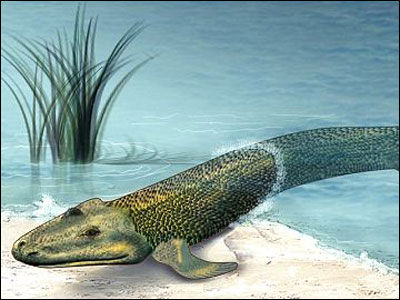人类或由有“第六感”的鱼类进化(图)
 模拟的有第六感的水中生物
模拟的有第六感的水中生物We may not have been able to see ghosts, but in our earlier, fish-like form, we did have a sixth sense, according to a study。
我们可能真的看不到鬼怪,但是在我们类似鱼的那些时候,根据一项科学研究,我们确实是存在第六感的。
Scientists have discovered that we are descended from a predatory fish-like ancestor that roamed the oceans 500million years ago and had 'electrosensors' - the ability to detect electric fields in water。
科学家们发现5亿年前在海洋中食肉性的类鱼类转化而来的,这种类鱼类的动物有在水中检测电场的能力。
It used this skill to detect prey, communicate and to find its way around。
它用此项技能探路,与其他鱼沟通并且找到周围正确的路。
Researchers at the University of Cambridge and Cornell University in New York believe that not just humans, but 65,000 living vertebrate species – that’s any creature with a spine or backbone - are descended from the beast。
在剑桥和纽约康奈尔大学的研究者却相信这不仅仅是人类的祖先,也是6万5千种活着的脊椎类动物的祖先。
This includes 30,000 species of land animals - including humans - and a similar number of ray-finned fish, the scientists found。
科学家们发现这些动物包括3万种陆地动物,和一小部分鳍刺类鱼。
Their conclusions, which appear in the latest edition of Nature Communications, mark the culmination of 25 years of work into the subject。
在最新版的自然通讯杂志上,他们发表了他们的结论,标志着25年的研究工作到达了定点。
‘This study caps questions in developmental and evolutionary biology, popularly called “evo-devo” that I've been interested in for 35 years,’ said Willy Bemis, Cornell professor of ecology and evolutionary biology and a senior author of the paper。
“这项研究覆盖了我已经研究了35年的发展与演化生物学上的问题”,康奈尔大学生态学和生物进化学的教授维利·彼米斯说。
He explains that hundreds of millions of years ago, there was a major split in the evolutionary tree of vertebrates。
他解释在几百万年前,在脊柱动物的进化史上有一次主要的改变。
One lineage led to the ray-finned fishes, or actinopterygians, and the other to lobe-finned fishes, or sarcopterygians。
一种进化成为了鳍刺类鱼,一种进化成了总鳍类鱼。
The latter gave rise to land vertebrates, some of which, such as the Mexican axolotl salamanders, retained electrosense ability。
后者是陆地脊柱动物的祖先,他们当中的一些还保持着探测电磁场的能力。
Some ray-finned fish, including paddlefish and sturgeon, also retained these receptors。
一些鳍刺类鱼,包括白鲟和鲟鱼,也有这样的探测神经。
Professor Bernis and his team found that the electrosensors of the ray-finned fish and the salamander developed in precisely the same pattern from the same embryonic tissue in the developing skin, confirming that this is an ancient sensory system。
贝尔尼斯教授和他的研究队发现具有电磁场探测功能的鳍刺类鱼和火蜥蜴正是以同样的模式发展来自同一胚胎组织在发展中皮肤,因此可以断定他们有同样的感官系统。
‘These two sensory systems share a common evolutionary heritage,’ added Bemis。
贝尔尼斯教授还说,“这两个感官系统共享一个遗传系统。”
However, over the years reptiles, birds and mammals lost their electrosense as it wasn’t needed for life on terra firma。
但是,由于在陆地上不需要这样的电子磁场探测系统,爬行类动物,鸟类和哺乳动物都渐渐失去了这一功能。(编译:刘佩琰)

